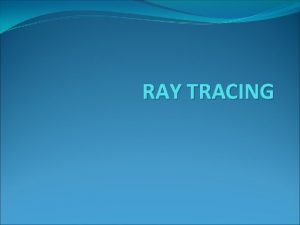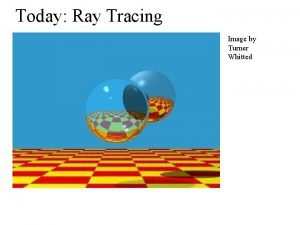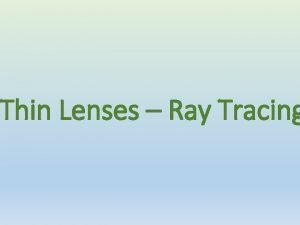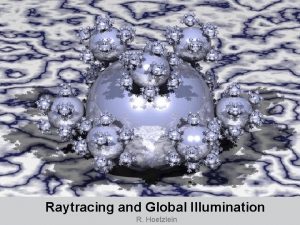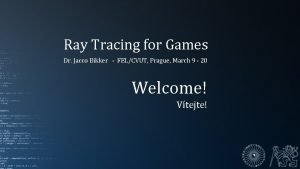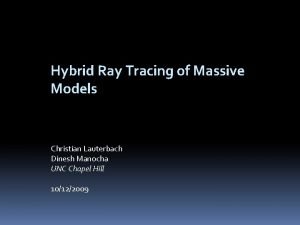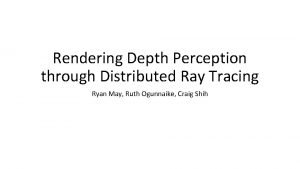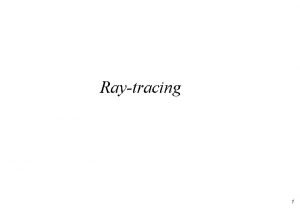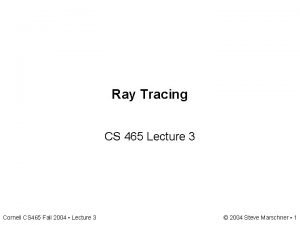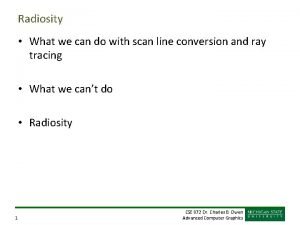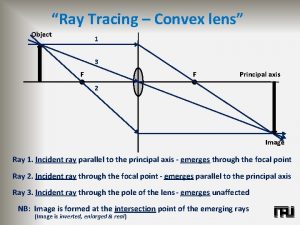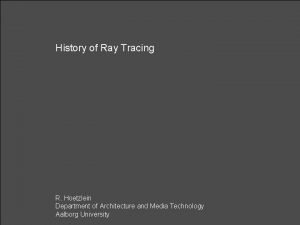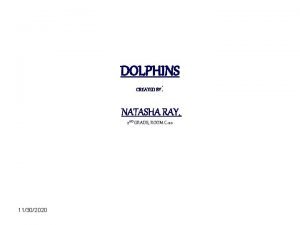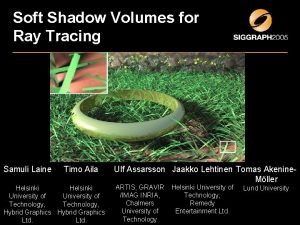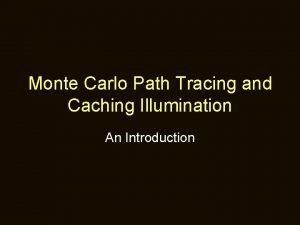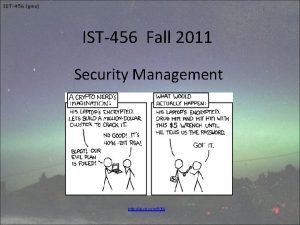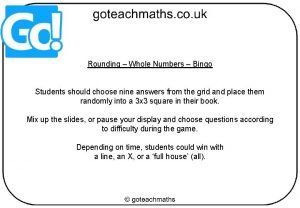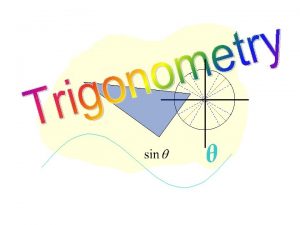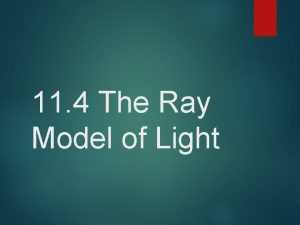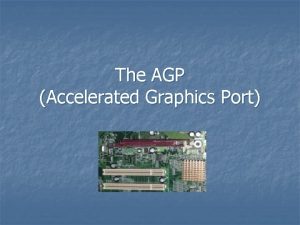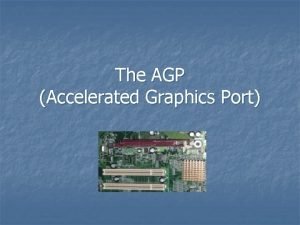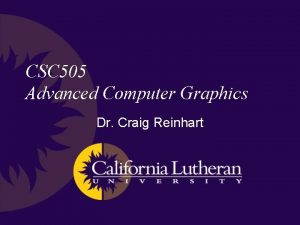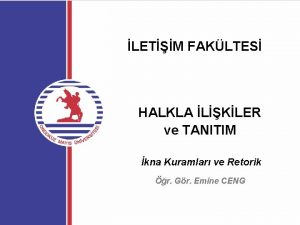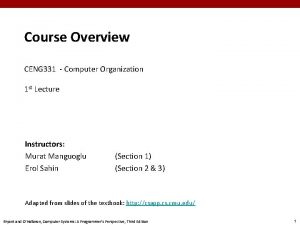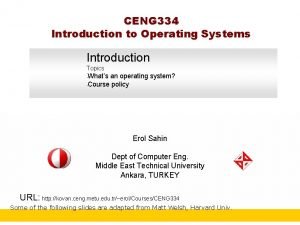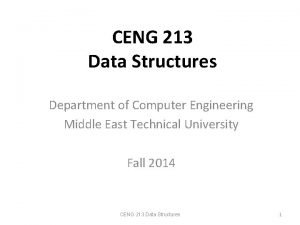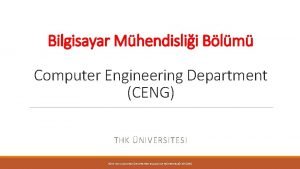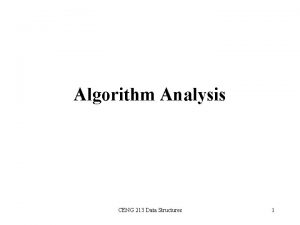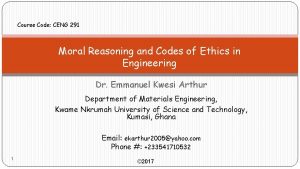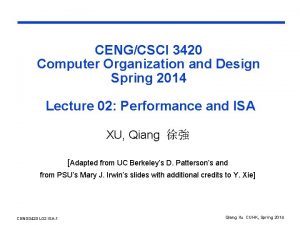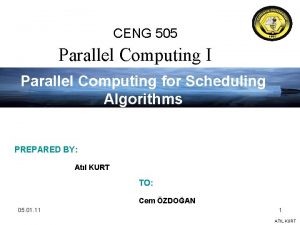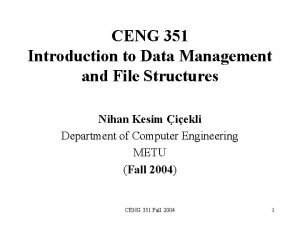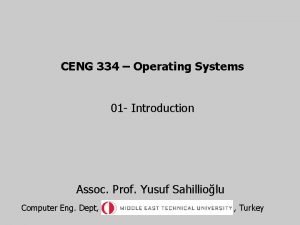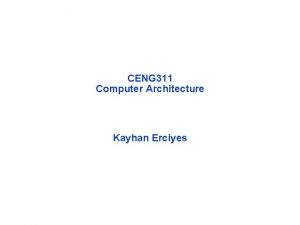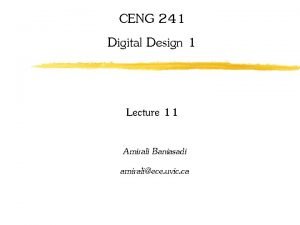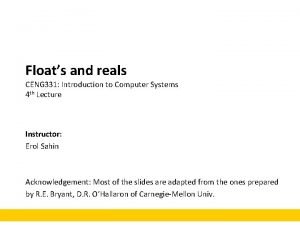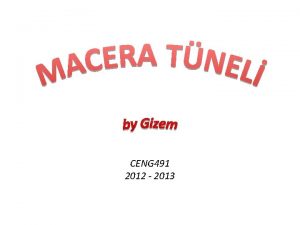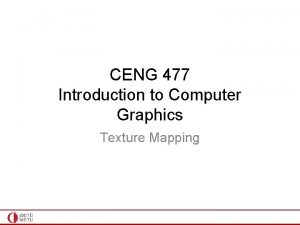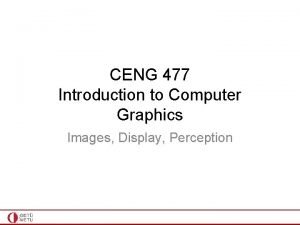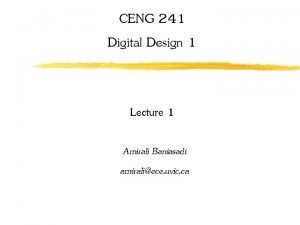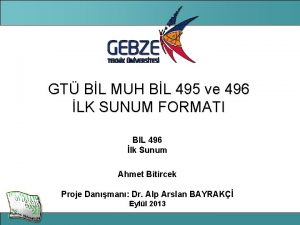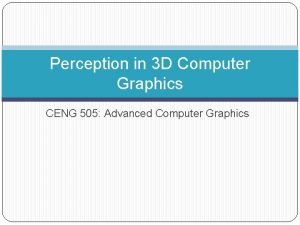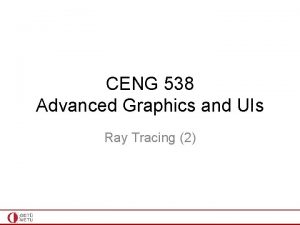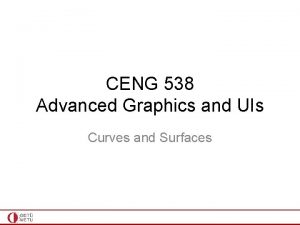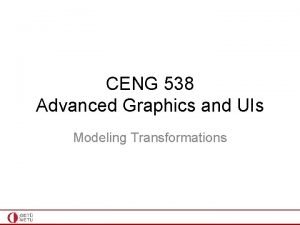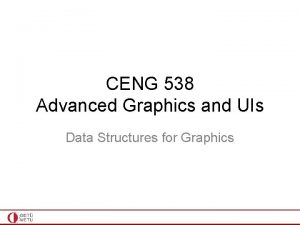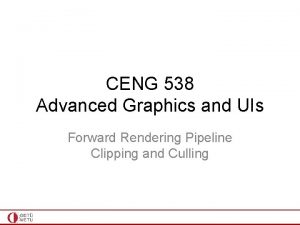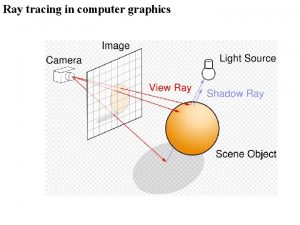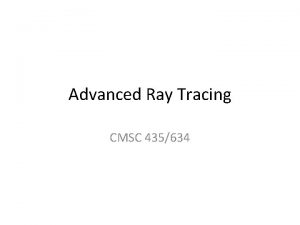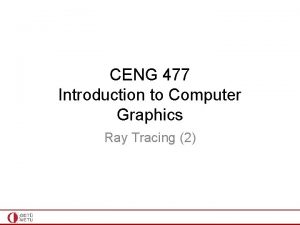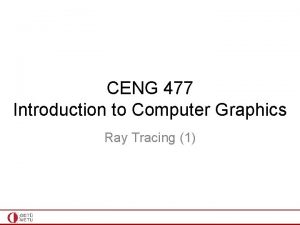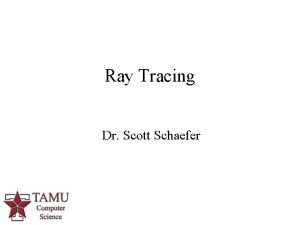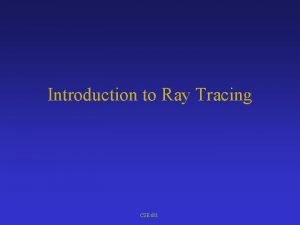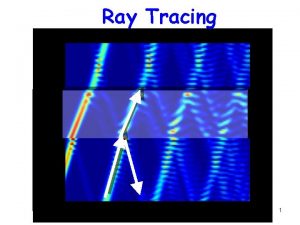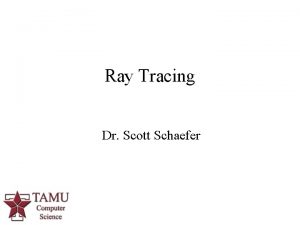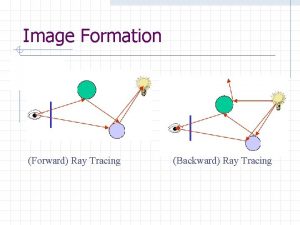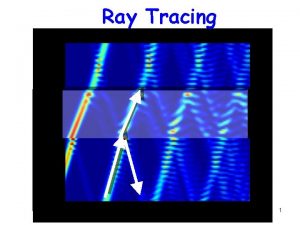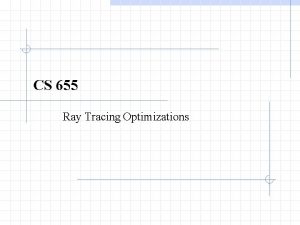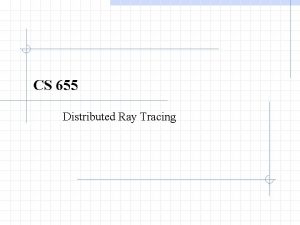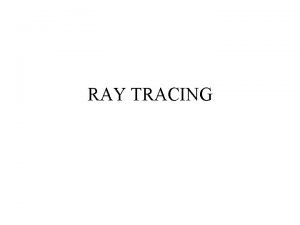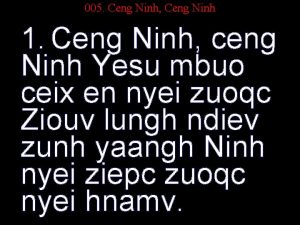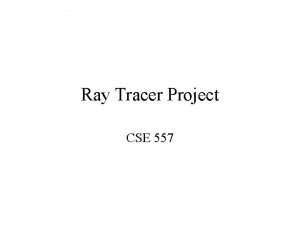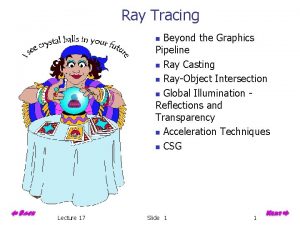CENG 538 Advanced Graphics and UIs Ray Tracing























































- Slides: 55

CENG 538 Advanced Graphics and UIs Ray Tracing (1)

Ray Tracing • In ray tracing, we model the propagation of light and its interaction with materials to create realistic images • Different from reality, we assume that the rays originate from the eye (or the camera) • This allows us to avoid processing rays that will not be visible to the eye (or the camera) wikipedia. com 2

Components • In RT, we have the following components: – – – Camera (or eye) Image plane Objects Light sources and lots of rays! 3

Camera • Camera represents the origin of the rays that we will trace • It is represented by a position (e) and orientation (u, v, w) • These vectors are orthogonal to each other v w e u • The position and the orientation are defined with respect to a global (or world) coordinate system • This global system has origin at (0, 0, 0) and its three axis are: (1, 0, 0), (0, 1, 0), (0, 0, 1) 4

Camera • The u, v, w vectors of the camera have the following meaning: – v: up vector – w: opposite of gaze vector – u: v x w with x representing cross-product v w e u 5

Image Plane • Image plane is a surface on which the final image is formed • It is divided into pixels through which rays will be cast (0, 0) • It is represented by its: – Resolution (nx, ny) – Distance to the camera – Left, right, top, bottom coordinates t l r • The image plane is typically centered and orthogonal with respect to the camera b v w e u distance (nx - 1, ny - 1) 6

Image Plane • Image plane is a surface on which the final image is formed • It is divided into pixels through which rays will be cast (0, 0) • It is represented by its: – Resolution (nx, ny) – Distance to the camera – Left, right, top, bottom coordinates • l, r, t, b are with coordinates with respect to the camera coordinate system (not the world coordinate system) t l r b v w e u distance (nx - 1, ny - 1) 7

Objects • Objects consist of mathematically defined geometrical shapes or meshes made up of triangles 8

Objects gamedev. ru cr 4. globalspec. com/ • It is possible to model complex shapes using a large number of small triangles or quadrilaterals 9

Objects James P. O’Shea Left to right: High-gloss, diffuse, mirrored, semi-gloss • Objects may have different materials that affect their appearance 10

Light Sources • Light sources provide the illumination in the scene • The geometrical relationship between objects and light sources may produce shadows • Typically, three types of light sources are used: – Ambient – Directional – Positional (Point) 11

Rays • origin direction parameter 12

Ray Tracing • The basic algorithm: for each pixel do compute viewing (eye, primary) rays find first object hit by ray and its surface normal n set pixel color to value computed from hit point, light, and n 13

Computing Eye Rays (0, 0) m = e + -wdistance q = m + lu + tv q l s = q + suu - svv su sv s(i, j) t m How to find su and sv? r sv = (t – b)(j + 0. 5)/ny b v su = (r – l)(i + 0. 5)/nx w e u How to write the final eye ray equation? r(t) = e + (s – e)t = e + dt What information did we use to derive this? distance (nx - 1, ny - 1) e: location of the camera distance: camera-image plane distance nx: image width ny: image height u, v, w: camera vectors r, l, t, b: image plane borders (in uvw space) 14

Some Example Values • • u = (1, 0, 0) v = (0, 1, 0) e = (0, 0, 0) nx = 1024 ny = 768 l = -1, r = 1 b = -1, t = 1 d = 1 Compute the ray equation passing through the pixel (256, 192): Where is this ray at t = 0, t = 1, t = 2? 15

Ray-Object Intersections • Goal: To decide at what point, if any, a 3 D line (ray) intersects a 3 D surface 16

Parametric Lines • A 2 D line can be represented as: y – mx – b = 0. This is called the implicit form • A parametric 2 D line can be represented as: x(t) = 2 + 7 t y(t) = 1 + 2 t • A 3 D parametric line (ray) can be written as: x(t) = 2 + 7 t y(t) = 1 + 2 t z(t) = 3 – 5 t • Alternatively, in vector form, we can write r(t) = o + td where o = (2, 1, 3) and d = (7, 2, -5) 17

Ray (Reminder) • A ray is a half-line represented by r(t) = o + td with t ≥ 0. • We want to know if a ray intersects an object with t in the interval [tmin, tmax] – If t < tmin, the object is too close (maybe in front of the image plane). – If t > tmax, the object is too far (outside the range we want to consider). 18

Implicit Surfaces • Rays will intersect surfaces, so we need to know how to represent surfaces • In implicit form a surface can be written as f(x, y, z) = 0 • Why is it called implicit? – You can test whether a point is on the surface, but you cannot generate points on the surface • Another way to write: f(p) = 0 where p = (x, y, z) • A ray will intersect this surface if: f(r(t)) = f(o + td) = 0 19

Ray-Plane Intersection • Consider the plane equation written in vector form as: . (p – a) n = 0 If you expand this, you get the familiar Ax + By + Cz + D = 0 equation n. (p-a)=0 n. p – n. a = 0 Ax+By+Cz – Ax’-By’-Cz’=0 // n. a = -D • Here, a is a point on the plane, n is the normal vector of the plane a n • a and n, are known quantities and p is the variable. 20

Ray-Plane Intersection • Simply plug r(t) = o + td into the previous equation: (o + td – a). n = 0 • Solving for t, we get: Using identities (wikipedia): t = (a – o). n / (d. n) • If t is in [tmin, tmax], the ray hits the plane and it is within the limits of our desired viewing range • What if d. n = 0? 21

Ray-Sphere Intersection • A sphere can be represented as: (x – cx)2 + (y – cy)2 + (z – cz)2 – R 2 = 0 • where c = (cx, cy, cz) is the center and R is the radius • In vector form, we can rewrite this as: (p – c) – R 2 = 0 • Again, plug in the ray equation to find t: (o + td – c) – R 2 = 0 22

Ray-Sphere Intersection • This gives: (d. d)t 2 + 2 d. (o – c)t + (o – c) – R 2 = 0 • Note that, this is a quadratic equation in t: At 2 + Bt + C = 0 t 2 • The solution is: t 1 • What if the discriminant D is less than zero? – Bounding sphere trick 23

Ray-Triangle Intersection • So far, we have been using implicit equations to represent surfaces: f(x, y, z) = 0 • Ray-triangle intersection is best found if the triangle is represented using a parametric form: x = f(u, v) y = g(u, v) z = h(u, v) • For instance, a sphere in parametric form can be represented as: x = r cosΦ sinΘ y = r sinΦ sinΘ z = r cosΘ 24

Ray-Triangle Intersection • Two techniques are possible: – Based on implicit form (ray-plane intersection followed by angle. Sum or same. Side tests) – Based on parametric (barycentric) coordinates 25

Implicit Method • First, intersect the ray with the plane of the triangle: – The plane normal can be found by cross product – The plane equation can be found from the normal and a point – Slide 21 a n c b 26

Implicit Method • If the ray intersects triangle’s plane, we need to determine if it is inside the triangle – We can resort to angle sums a p c b 27

Implicit Method • If the ray intersects triangle’s plane, we need to determine if it is inside the triangle – We can resort to cross and dot products – (B-A) x (p-A) points out of the screen (for any p above AB) – (B-A) x (p’-A) points into the screen (for any p’ below AB) – What direction should x point in? • Take reference point C which is on a certain side of AB • Any point p where (B-A)x(p-A) not point in the same direction as (B-A)x(C-A) not in triangle 28

Parametric Method • A triangle is best parameterized using barycentric coordinates: p(α, β, γ) = αa + βb + γc c with the constraints 0<α<1 0<β<1 0<γ<1 and α+β+γ=1 Ab Aa α = Aa / A β = Ab / A γ = Ac / A Ac a • What does it mean if α = 0 or β = 0 or γ = 0? • What if both α = 0 and β = 0? b 29

Parametric Method • Note that we can eliminate one of the parameters: α=1–β–γ p(β, γ) = a + β(b – a) + γ(c – a) • Then the point p is inside the triangle if and only if: β+γ<1 0<β 0<γ • The ray r(t) = o + td hits this plane where: o + td = a + β(b – a) + γ(c – a) 30

Parametric Method • How to solve for t? • Expand from the vector form into individual coordinates: ox + tdx = ax + β(bx – ax) + γ(cx – ax) oy + tdy = ay + β(by – ay) + γ(cy – ay) oz + tdz = az + β(bz – az) + γ(cz – az) • The unknowns here are t, β, and γ. • We have 3 equations and 3 unknowns. 31

Parametric Method • Rewrite this system in matrix form: • And solve for t, β, and γ using Cramer’s rule. 32

Parametric Method • Cramer’s rule: where |. | denotes the determinant. 33

Parametric Method • If A is equal to: • Then |A| is given by: 34

Parametric Method • Use this to find the determinants of the other terms and compute t, β, and γ. • The ray will intersect the triangle if: tmin ≤ tmax β+γ<1 0<β 0<γ • Ray-triangle intersection is the most important as any complex object can be represented using a set of triangles! 35

Complex Models • Bunny model composed of 725, 000 triangles From Stanford University 36

Complex Models • Buddha model composed of 9, 200, 000 triangles From Stanford University 37

Complex Models • Dragon model composed of 5, 500, 000 triangles From Stanford University 38

Complex Models • Armadillo model composed of 7, 500, 000 triangles From Stanford University 39

Complex Models • Lucy model composed of 116, 000 triangles From Stanford University 40

Complex Models • Let’s compute how many intersection tests we need to perform to render a model composed of 1, 000 triangles with an image size of 1024 x 768. • 1, 000 * 1024 ≈ 1, 000, 000 (one trillion) • That’s why ray tracing is generally slow. • Luckily, the number of intersection tests can be significantly reduced by using acceleration structures. 41

Multiple Intersections • Find intersection with front-most primitive in scene 42

Ray-Cylinder Intersection • More intersections with mathematically defined objects • Recall our ray is r(t) = o + td • Elliptical cylinder whose base is centered on x-y plane origin – x 2 + m 2 y 2 = r 2 – 0≤z≤h – m = r/s (circular iff r=s) 43

Ray-Cylinder Intersection • 44

Ray-Box Intersection • A box is described by 6 plane equations – – – x = 0 x = rx y = 0 y = ry z = 0 z = rz • Our ray is described by r(t) = o + td • Idea: A ray intersecting one of these planes (x = rx) must not go out of bounds in the other dimensions (0, ry, rz) 45

Ray-Box Intersection • Ray intersects x = rx plane at t = (rx - ox) / dx • Check if this t stays in-bounds for the other dimensions: – 0 ≤ r(t). y ≤ ry – 0 ≤ r(t). z ≤ rz 46

Realism • Intersection tests give us the surface position that is hit by a ray. • To create realistic images, we need to compute realistic models of light-surface interaction at that point on the surface. • This will be the topic of the next lecture. From ACM Siggraph 47

More on x- and dot-products • Before the realistic color models, let’s see more applications of cross-product and dot-product. • Question: Distance between 2 lines in 3 D? 48

More on x- and dot-products • Distance between 2 lines in 3 D? • • a=(p 2 – p 1) and x=(v 2 – v 1) must be perpendicular: a. x = 0 b=(p 4 – p 3) and x=(v 2 – v 1) must be perpendicular: b. x = 0 a 0 x 0 + a 1 x 1 + a 2 x 2 = 0 2 equations 3 unknowns b 0 x 0 + b 1 x 1 + b 2 x 2 = 0 49

More on x- and dot-products • Distance between 2 lines in 3 D? • • Replace v 1 with p 1 + t(p 2 - p 1); similarly v 2 = p 3 + s(p 4 - p 3) 2 eqs 2 unknowns; solve for t and s Find v 1 using t and v 2 using s Answer = ||v 2 - v 1|| 50

More on x- and dot-products • Distance between a point and a line? • a = point where red-black intersects • (p-a). v = 0 • 1 equation 3 unknowns (ax, ay, az) 51

More on x- and dot-products • Distance between a point and a line? • • a = point where red-black intersects (p-a). v = 0 Replace a with p 0 + tv (p - p 0 - tv). v = 0 • At 2 + Bt + C = 0 situation gives t • t gives a and answer = ||p-a|| 52

More on x- and dot-products • Distance between a point and a plane? 53

More on x- and dot-products • Distance between a point and a plane? • d = (p-p 0). n where ||n||=1 • d = ((p-p 0). n) / ||n|| in general 54

More on x- and dot-products • Distance between a point and a plane? • • • Alternative solution: (p’ – p 0). n = 0 //p’ = p. projection (p + tn - p 0). n = 0 (p - p 0). n + tn. n = 0 t = (p 0 - p). n / ||n||2 • d = ||p – p’|| = ||p – tn|| = -t||n|| • d = -(p 0 - p). n / ||n||2 * ||n|| = ((p - p 0). n) / ||n|| 55
 Ray tracing and ray casting
Ray tracing and ray casting Whitted ray tracing
Whitted ray tracing Thin lens ray tracing
Thin lens ray tracing An improved illumination model for shaded display
An improved illumination model for shaded display Ray tracing actor
Ray tracing actor Christian lauterbach
Christian lauterbach Depth of field ray tracing
Depth of field ray tracing Recursive ray tracing
Recursive ray tracing Albrecht dürer ray tracing
Albrecht dürer ray tracing Ray tracing vs radiosity
Ray tracing vs radiosity Ray tracing c#
Ray tracing c# Ray tracing convex lens
Ray tracing convex lens History of ray tracing
History of ray tracing Qualcomm ray tracing
Qualcomm ray tracing Natasha ray
Natasha ray Ray tracing lenses
Ray tracing lenses Samuli laine
Samuli laine Monte carlo ray tracing
Monte carlo ray tracing Xkcd 538
Xkcd 538 Establecimiento del papado 538
Establecimiento del papado 538 Rounding bingo
Rounding bingo Tan 30
Tan 30 Graphics monitors and workstations in computer graphics
Graphics monitors and workstations in computer graphics Ray model of light
Ray model of light Raster scan display and vector scan display
Raster scan display and vector scan display Accelerated graphics port year created
Accelerated graphics port year created Advanced higher graphic communication
Advanced higher graphic communication Agp
Agp Craig reinhart
Craig reinhart Dot matrix display ppt
Dot matrix display ppt What are the focal points of fingerprint
What are the focal points of fingerprint Emine ceng
Emine ceng International professional engineer
International professional engineer Cow.ceng.metu.edu tr
Cow.ceng.metu.edu tr Imeche ceng application example pdf
Imeche ceng application example pdf Ceng 334
Ceng 334 Cow ceng metu
Cow ceng metu Thk yazılım mühendisliği
Thk yazılım mühendisliği Citp vs ceng
Citp vs ceng Ceng 213
Ceng 213 What is the difference between ethics and law
What is the difference between ethics and law Ceng 3420
Ceng 3420 Ceng 505
Ceng 505 Ceng351
Ceng351 Ceng 334
Ceng 334 Iyte ceng
Iyte ceng Ceng 241
Ceng 241 Double float
Double float Bahri tokmak
Bahri tokmak Vray roadmap
Vray roadmap Ceng 477
Ceng 477 Ceng 241
Ceng 241 Nem ceng
Nem ceng Ceng 112
Ceng 112 Gtü ceng
Gtü ceng Ceng 505
Ceng 505
